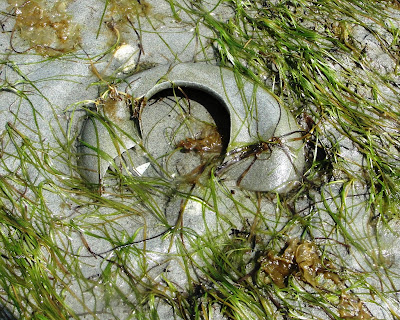I’ll save many of today's photos for another post. For this entry, I want to share what I learned about one of my favourite shells. From my first week here, I have been finding large, broken, empty, round shells, about 3 inches in diameter, with beautiful shiny insides. From previous posts you may remember this:

Or this:
In those shots, the inhabitant had long vacated the residence. But today, everywhere I looked, I saw the Real Deal – inhabited, intriguing, amazing moon snails. Specifically, they are Lewis’ Moon Snails, or Euspira Lewisii, a gastropoda from the family Naticidae. (To learn more about sea shells of British Columbia, check out this website).
The name Lewis’s Moon Snails, according to another website, honours Meriwether Lewis, who with William Clark (and led by a young Indian woman named Sacajawea) explored the route to the Pacific in the early 1800s, and brought back specimens of this edible shellfish, the largest of all moon snails.
The first indicator of the snails is a fist-sized mound of sand, which looks like this:
(Note: you can click on any image to enlarge, then use your back browser to return to the blog.)
As we approach, the snail retreats quickly. To do this, it must pull itself into its shell completely – made possible by expelling all water in a huge geyser which rises up in two large streams to a height of about 8 – 10 feet, a Crofton version of Yellowstone Park geysers! I was only able to capture a couple of feet as the whole event is over in seconds and the mound has become nothing more than a small hole in the sand.
(Edited to add: the above pictures may, in fact, be the mound and water geyser of the geoduck clam rather than the moon snail. While several sources speak of the moon snail forcefully expelling water in order to retreat into its shell, the geoduck is more famous for these shoreline geysers. Both geoducks and moonsnails share the same environment - the moonsnails feeding on the geoducks.)
But on many occasions, we found the snail extended out of its shell (it can extend up to a foot in diameter), sitting on the sand with little concern for its safety.

Apparently its primary predators are humans and “sunflower stars”, which are starfish common to the northwest, with 16-24 limbs or ‘rays’. The starfish, in turn, are prey for king crab which, I have just learned from Wikipedia while researching the Moon Snail, is the name of the weird crab whose photo I posted in an earlier blog:
The king crab are eaten by other local sealife such as halibut and sea otters and, of course, humans.
But back to the Lewis’ moon snail. All over the beach we found what appeared to be pieces of tires. They were, in fact, the egg casts or ‘sand collars’ of the moon snail, comprised of hundreds of tiny snail eggs bound together by mucus and sand.

These sand collars are large - a good 12-15 inches across. As the eggs hatch and the larvae merge with the plankton to grow and mature into little moon snails, the sand collars break down leaving “tire treads” all over the boggy sand.

And there is lots for the maturing moon snails to survive on – they simply drill a hole in the shell of clams and oysters and mussels and suck out the insides – in fact, they are the bane of oyster farms and clam beds. They can also suffocate their prey with their giant, gelatinous foot - if dogs, humans, oil spills, log booms, gulls or starfish don’t get them first.
One simple walk on the beach leads to a quick google inquiry to find out a shell’s name, which leads to a fascinating lesson in biodiversity. Moon Snails, starfish, king crab, halibut, humans .....all interrelated, each dependent on another.
4 comments:
wow, that is fascinating! Thanks for sharing this
For several years now we've been rowing our boat around Brentwood Bay and saw those sand collars and had NO idea what they were. We even pulled one up out of the water because at first we thought it might be pottery. We saw a lot of moon snails in this area today and now thanks to your blog we finally know what those weird rubbery looking items are...the sand collars! Thanks!!
So glad to be of help! They do look like a piece of pottery, smooth and still wet from the potter's wheel, ready for the kiln - so thanks for that imagery!
I , as like " Brentwood Bay", did NOT know about those collars and have lived most of my 60 yrs here on the island. Thank you !! inturn I shall pass this wonderful bit of knowledge onto my grandchildren. PS how do the inside of Moonsnail shells colour up and stay shiny ???
Post a Comment